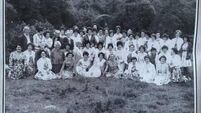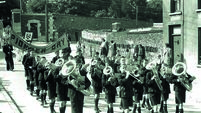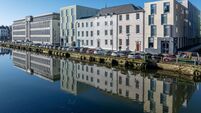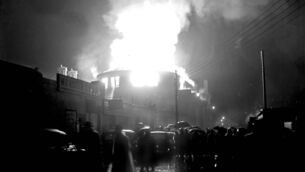My 40-hour round trip from Cork to Wembley to see Ireland play
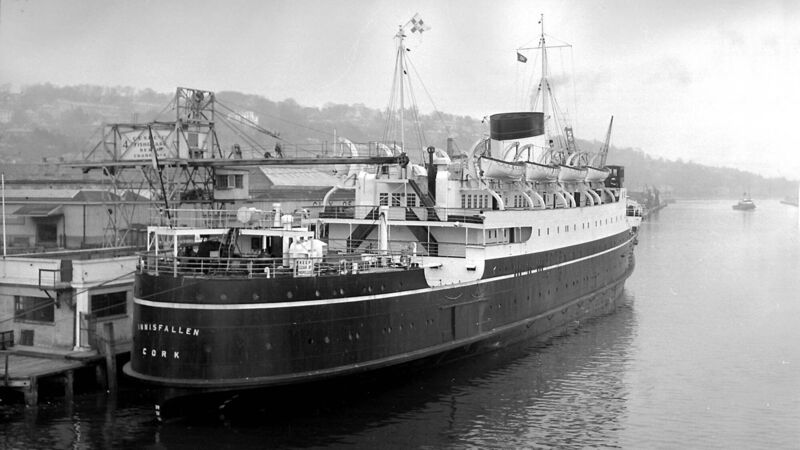
The Innisfallen tied up at Penrose Quay in February, 1957 - reader Donal Donovan made his trip to Wembley three months later - but the Innisfallen was not an option for him as she didn’t depart Cork on Tuesdays.
WE have all had some very pleasant times over the past couple of years on this page, recalling train travel to Youghal, to West Cork, to Rosslare, to Dublin, haven’t we?
Everybody loves to remember the days when you really could go anywhere by rail and it was an adventure in itself.
And we have had some happy memories of taking the boat too (back when we did have one of our very own, the never-to-be-forgotten Innisfallen, or, failing that, the Rosslare one.
Now, in this week's Throwback Thursday, Donal Donovan has sent us a delightful story from the 1950s, combining both rail and boat, when he and a pal set off on an exciting trip to the far-flung home of football Nirvana in neighbouring England.
“On Tuesday, May 7, 1957, my friend Brian Scannell and I boarded the 5.40pm boat train at Glanmire Road station, bound for Rosslare Harbour,” recalled Donal.
“Our ultimate destination was Wembley Stadium where Ireland was due to play England in a World Cup qualifier the following afternoon. Attendance at a World Cup fixture against the old enemy was a no-brainer, so off we went!”
Donal continued: “Travel by the Innisfallen from Cork was not really an option, unfortunately, as that grand old vessel sailed only on Mondays, Wednesdays and Fridays, and would have involved spending two nights in London, while the Rosslare ferry sailed every weekday. This was long, long before the days of budget airline travel, remember!” (Well, that is understandable for the Innisfallen, since it had a longer journey to get to Fishguard, so out from our side the even days, and back from Wales the odd days.

“Our train took us to Mallow, where it then branched off on the 114-mile link through Fermoy, Dungarvan, Waterford, and south Wexford,” added Donal.
“It was beautiful countryside all the way, and took four hours. A short sea journey from Rosslare Harbour to Fishguard followed, leading to yet another train journey on to London, taking five hours, but getting us there in plenty of time for the match.
“The return journey followed a similar pattern, and we duly arrived home about 9am on Thursday morning. Probably a bit tired, but you didn’t notice things like that back then.”
Donal says he was 23 at the time and got the idea of going to the match from an advertisement in an Irish newspaper of an excursion being organised by Shelbourne FC.
“I paid a deposit of five shillings towards a booking, but subsequently realised that of course I could go from Cork, so I cancelled Shelbourne, who caused no difficulties, but lost my enormous deposit - and five shillings was a lot back then!”
He cannot recall however how much the fare from Cork to London cost, but does recall that he booked the actual match tickets from the Football Association of Ireland.
“They probably cost about ten shillings each in an open seated stand.
“The old Wembley was a magnificent stadium, but was less than half full for that particular match. Two Corkmen, my namesake Don Donovan, and Noel Cantwell, were the Ireland full backs, and four of Manchester United’s famous Busby Babes played - three for England and Liam Whelan for Ireland.
“They all perished the following February in the dreadful Munich air crash.”
A few years later, during the 1960s, Donal travelled by the Innisfallen with a work colleague, John Cody, to Cardiff for rugby matches.
“These trips were much more straightforward - you sailed from Cork on a Friday, went to the match on Saturday, and got home Sunday morning.”
Oh, how the days of yore resonate in our memories! And those services - taken for granted back then - gone, gone forever!
“The direct service to Rosslare ceased in 1967,” said Donal. “Much of the track was lifted without further ado.
“It was still possible to access a rail connection to Rosslare from Cork, but now passengers were required to take the Dublin train and change at Limerick Junction.
“Eventually, that service also came to an end, and a portion of the line from Waterford to Rosslare was lifted.
“Nowadays, all that remains for pedestrian passengers is a bus to Rosslare, but at least it’s an option for those who may find air travel difficult (or unobtainable, since so many short-hop flights out of Cork seem to have disappeared).”
All this, Donal says, is by way of being a preamble to something everyone will respond to - “travelling the Innisfallen Way, which was the most enduring and beloved service between Cork and Wales.
“Five vessels bore that hallowed name over a period from 1896 to 1983, two of them becoming war casualties.
“A summer sailing from Cork was akin to a mini cruise - a trip down the River Lee for starters, followed by a tour of Cork Harbour and further cruising off the south coast, with the option of a good dinner and the best part of a night’s sleep in a comfortable bunk. All at a cost of course!”
Budget airlines and cheap flights are undeniably far more economical and time-saving today, commented Donal wryly, “but they are no fun. How can they compare with travelling the Innisfallen Way?”
Alas, changing traffic and cargo patterns made the Innisfallen unsuitable - according to those at the top anyway - and so it was replaced by a succession of car ferries run by different companies, none of which ever really succeeded in being profitable.
“Consequently, there is still only Rosslare left to provide the best ‘old way’ option for Corkonians wishing to travel to the UK.
Incidentally, adds Donal as an afterthought, Ireland lost that match at Wembley back in 1957! Further research shows it was 5-1, with Dubliner Dermot Curtis scoring for Ireland; Tommy Taylor - who also lost his life at Munich the following year, scored a hat-trick for England.
Who of the older generation does not mourn the passing of the Innisfallen, bewail the loss of that splendid ship proceeding up the Lee in all its glory? It was part of our city, part of our lives, especially when the older one - all brass and polished mahogany - berthed right on Horgan’s Quay, and swung cattle and cars on and off in nets, but even still when its newer slim and elegant version moored lower downriver at Silversprings.
To travel on it was one of life’s experiences, and a source of pride for all Corkonians. Oh, we want it back, we want it BACK!
Coincidentally, Tim Cagney has revived for readers of Throwback Thursday the memory of another famous vessel, The Mary Stanford. This celebrated lifeboat operated out of Ballycotton for many years, and Tim’s story makes stirring reading. We who live so close to the coast know only too well what havoc the wind and weather can wreak. Our lifeboats and their incredibly brave crews know it too.
“On February 7, 1936, a huge storm sprang up to the south-east of the Cork coast,” said Tim.
“Such was the ferocity of the winds that waves, breaking on the shoreline at Ballycotton, sent spray above the lantern of the lighthouse, a height of 196ft, and rocks - each weighing a ton - were tossed-about like sugar lumps.

On the morning of February 11, the Ballycotton lifeboat station received a call to the effect that the crew of a lightship, The Comet, might be in peril. This stood guard over an underwater hazard known as Daunt’s Rock, off the coast of nearby Robert’s Cove. The Mary Stanford was launched, and subsequently came upon The Comet, which - by that stage - had been ripped from her moorings at the Rock.
Luckily, her crew had managed to engage her anchor, to stop her drifting into shipping-lanes. A steel cable was thrown across The Comet, in the hope that this would enable her to be towed to safety. The cable snapped, so The Mary Stanford had to sail to Cobh to get a stronger one. When she returned to The Comet, the weather had become so bad that towing was no longer an option. The Mary Stanford had to position herself alongside The Comet, and the crew of the latter had to actually jump aboard the lifeboat, or be physically pulled aboard it by her crew. “
Some 63 hours after she had left Ballycotton, The Mary Stanford delivered the crew of the lightship to Cobh. In all that time, her crew had had only three hours’ sleep, and survived on ship’s biscuits. (These - also known as ‘hard tack’ - were a somewhat bland concoction of medium-coarse stone-ground flour, salt and water. They were about a half-inch thick, and formed a staple diet of mariners in the days before the invention of tinned foods.)
Tim added: On February 14 - St Valentine’s Day - The Mary Stanford returned to Ballycotton. Almost incredibly, The Comet, which had been towed to Cobh by the Irish Lights vessel, Isolda, was back at her post on Daunt’s Rock after just a day, following repairs by a ship’s carpenter.
“In recognition of his bravery and fortitude, Coxswain Patrick Sliney was awarded a gold medal, while 2nd Coxswain John Lane Walsh and motor mechanic Thomas Sliney were both awarded silver medals. Bronze medals were awarded to crew-members Michael Coffey Walsh, John Shea Sliney, William Sliney and Thomas Walsh. (Note how many of those have the same family name - truly a local tradition of service and bravery.)
Most significant of all, however, was the conferring of a gold medal upon The Mary Stanford herself - the first time such an award had been accorded to a vessel, since the foundation of the RNLI in 1824.”
To the best of his knowledge, said Tim, such an accolade has never since been replicated.
“The awards ceremony was held in London and the dignitaries present included the Duke of Kent, who would later abdicate as King Edward VII,” said Tim. “A donation of £60 was made by the Irish Lights Commissioners, in gratitude for the service. The RNLI received an anonymous donation of £50. Also, a somewhat poignant donation of 4 shillings and sixpence was collected by 16 children from a school in Derbyshire, after they had read of “a wonderful work of rescue off the Irish Coast”. On Lifeboat Day, in Greater London, a half-crown was dropped into a collection box, with the comment ‘that’s for Ballycotton.’.
“The Mary Stanford served as a lifeboat in Ballycotton from 1930 to 1959. After retirement, she languished in a backwater of Dublin’s Grand Canal Dock for some 20 years, and was in danger of being scuttled. However, the good people of Ballycotton wanted her back. In 2013, a group called the Seafood and Shanty Ballycotton Business Development Committee started a fundraising drive to get her back where she belonged. Thus it was that, on April 29, 2014, The Mary Stanford came home.
“She has since been beautifully restored, and now sits proudly on a plinth at her native port, overlooking the iconic lighthouse.
“In 1974, to mark the 150th anniversary of the RNLI, a commemorative postage stamp was issued in the Isle of Man. This featured a very dramatic painting by the artist Bernard Gribble, portraying the heroic rescue carried-out by The Mary Stanford crew.”
Do you have memories of the sea, the shore, storms and shipwreck? Or travelling by the great old Innisfallen? Let us share your stories. Email jokerrigan1@gmail.com or leave a comment on our Facebook page: https://www.facebook.com/echolivecork.
